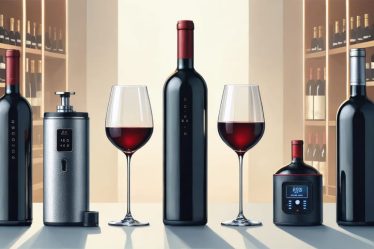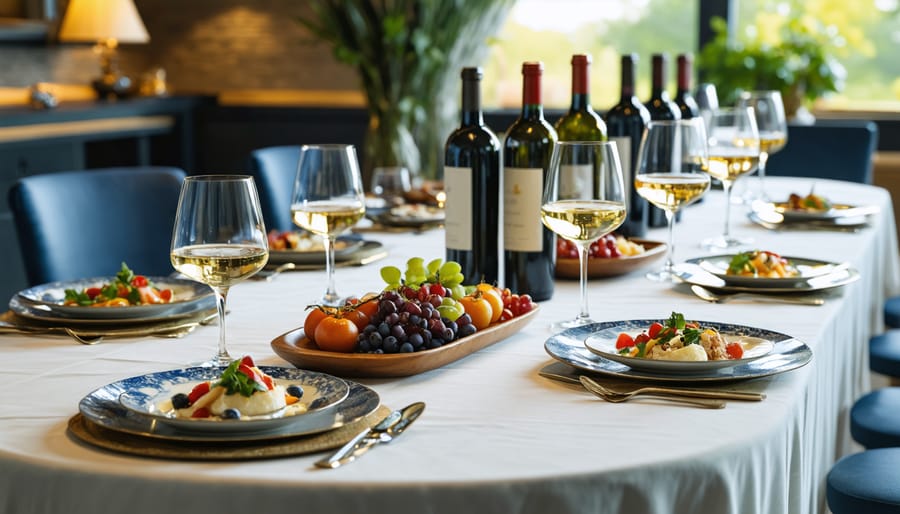
Transform your dinner party into an unforgettable fine dining experience with a perfectly orchestrated five-course meal and wine pairing. Like composing a symphony, each course and its accompanying wine creates a harmonious progression that delights the senses and elevates the entire dining experience.
From the delicate sparkle of champagne with fresh oysters to the rich embrace of a bold Cabernet alongside perfectly seared beef, wine pairing is an art that turns a good meal into an extraordinary celebration. Whether you’re hosting an intimate gathering or marking a special milestone, understanding the interplay between food and wine unlocks a world of flavors that dance on the palate.
In this guide, we’ll walk through each course – from amuse-bouche to dessert – revealing the secrets of selecting wines that not only complement but enhance every bite. You’ll discover how to build tension and release throughout the meal, creating moments of pure gastronomic pleasure that your guests will remember long after the last sip of dessert wine.
Let’s embark on a journey through five carefully curated courses, each thoughtfully paired with wines that bring out the best in both the food and the moment.
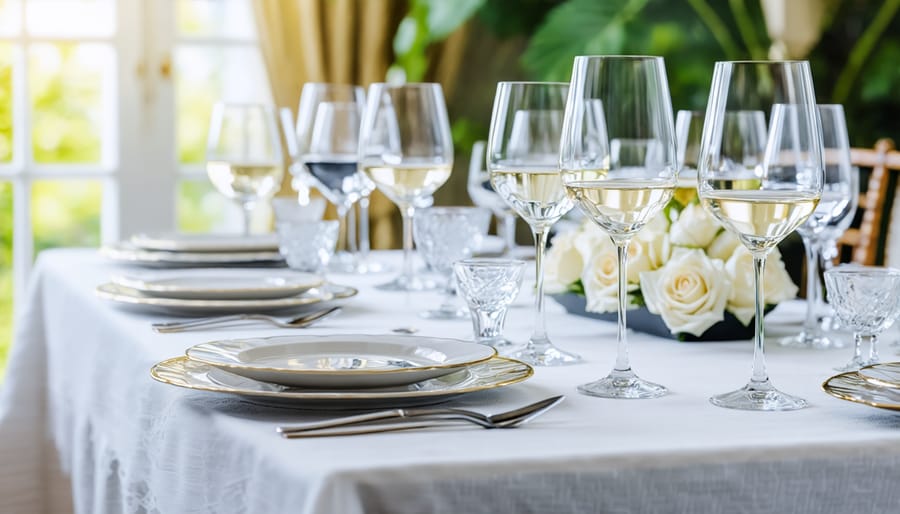
First Course: Setting the Stage with Appetizers
Suggested Appetizer Combinations
Let’s kick off your meal with some foolproof appetizer and wine combinations that’ll wow your guests from the very first bite. My personal favorite is a classic bruschetta topped with fresh tomatoes, basil, and extra virgin olive oil, paired beautifully with a crisp Pinot Grigio. The wine’s light, citrusy notes complement the fresh tomatoes without overwhelming them.
For a more sophisticated starter, try pan-seared scallops with a butter sauce, matched with an unoaked Chablis. Trust me, the wine’s mineral qualities and subtle fruit notes create magic with seafood! If you’re feeling adventurous, serve a fig and goat cheese tart alongside a glass of Prosecco – the bubbles cut through the cheese’s richness while enhancing the figs’ sweetness.
For meat lovers, prosciutto-wrapped melon with a glass of dry rosé creates a perfect balance. The wine’s fruity character pairs wonderfully with both the salty prosciutto and sweet melon. And for a crowd-pleasing vegetarian option, try mushroom vol-au-vents paired with a light Beaujolais – the wine’s earthy notes echo the mushrooms’ umami flavors beautifully.
Wine Spotlight: Light Whites
Let’s start our wine journey with the delightful world of light whites, perfect for awakening the palate at the beginning of your meal. When I first explored wine tasting fundamentals, I discovered that these crisp, refreshing wines are ideal for setting the tone of your dining experience.
Consider starting with a vibrant Pinot Grigio from northern Italy, known for its subtle pear and citrus notes, or a zesty New Zealand Sauvignon Blanc with its characteristic gooseberry and tropical fruit flavors. These wines typically feature moderate alcohol content (11-13%) and bright acidity, making them perfect companions for lighter starter courses.
My personal favorite is a German Riesling Kabinett, with its delicate balance of sweetness and acidity. The lower alcohol content and subtle mineral notes create a beautiful harmony with seafood appetizers or light salads. Remember, serving temperature matters – aim for around 45-50°F (7-10°C) to bring out the best in these delicate whites. For extra elegance, try serving your light whites in tulip-shaped glasses to concentrate their subtle aromas.
Second Course: The Soup Experience
Matching Wines with Different Soup Bases
Let me share a little secret that transformed my own dinner parties: matching wines with soups is all about complementing their base. For cream-based soups, like velvety butternut squash or mushroom bisque, reach for a full-bodied white wine with buttery notes. A California Chardonnay or a rich Viognier works beautifully here, their creamy texture mirroring the soup’s luxurious feel.
When serving clear broths or consommés, think lighter and brighter. A crisp Pinot Grigio or a light-bodied Sauvignon Blanc adds a refreshing touch without overwhelming the delicate flavors. I learned this the hard way after once pairing a heavy red with my grandmother’s crystal-clear chicken consommé – let’s just say it wasn’t my finest hosting moment!
For Asian-inspired soups with complex broths, like pho or miso, consider an off-dry Riesling. Its subtle sweetness and bright acidity can handle the umami and spice while cleansing your palate. Remember, the key is finding balance – you want the wine to enhance, not compete with, your soup’s distinctive character.
Perfect Pairings for Popular Soups
When it comes to soups, the right wine can elevate your first course from comforting to extraordinary. For classic French onion soup, reach for a light-bodied red like Beaujolais or Pinot Noir – their subtle earthiness perfectly complements the caramelized onions and rich broth. One of my favorite combinations is butternut squash soup paired with an oaked Chardonnay; the wine’s buttery notes dance beautifully with the soup’s creamy texture.
For seafood-based soups like lobster bisque or clam chowder, a crisp Chablis or unoaked Chardonnay works wonders. Their mineral qualities and bright acidity cut through the richness while enhancing the delicate seafood flavors. If you’re serving a hearty minestrone or vegetable soup, try a medium-bodied Verdicchio or Soave – these Italian whites offer enough body to stand up to the vegetables while maintaining a refreshing quality.
Remember, temperature matters! Serve your wines slightly cooler than room temperature for reds and properly chilled for whites to ensure the best tasting experience.
Third Course: The Fish or Pasta Interlude
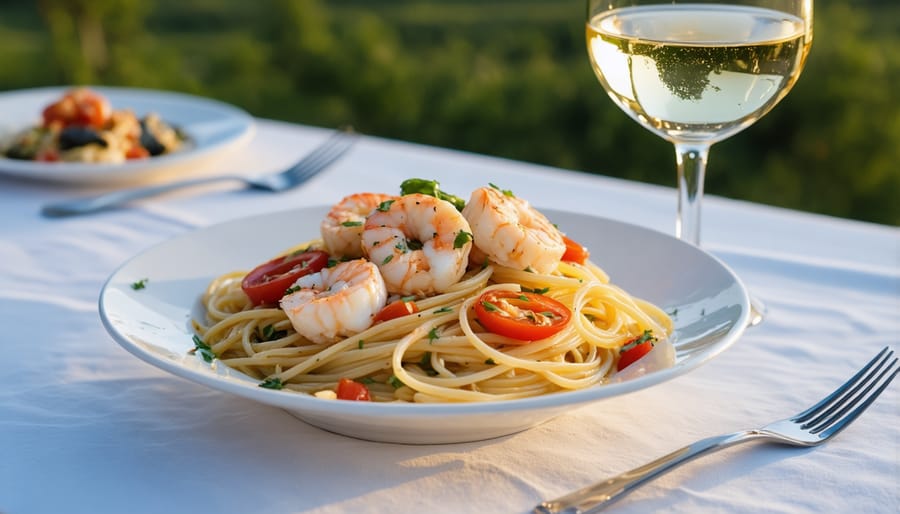
White Wine Selection Tips
When it comes to selecting the perfect white wine for fish courses, I’ve learned that the key is to strike a balance between complementing the delicate flavors while adding a layer of sophistication to your dining experience. Following basic food and wine pairing principles, look for crisp whites with bright acidity and mineral notes.
For lighter fish dishes like sole or sea bass, reach for a Chablis or Pinot Grigio – their subtle citrus notes won’t overpower the fish’s natural flavors. If you’re serving a richer fish like salmon or sea bream with a buttery sauce, consider a lightly oaked Chardonnay or Viognier. These fuller-bodied whites can stand up to the dish while maintaining harmony.
Here’s my tried-and-true tip: think about the sauce as much as the fish itself. Cream-based sauces work beautifully with buttery Chardonnays, while citrus or herb-forward preparations shine alongside Sauvignon Blanc or Vermentino. Remember, there’s no need to break the bank – many excellent options are available in the $15-30 range that will elevate your fish course beautifully.
Alternative Pairings for Pasta
When it comes to pasta, the possibilities for wine pairings are delightfully diverse! For tomato-based pasta dishes like classic spaghetti marinara, reach for a medium-bodied Chianti or Sangiovese – their natural acidity perfectly complements the bright tomato flavors. If you’re serving a creamy pasta like fettuccine alfredo, opt for a buttery Chardonnay or a crisp Pinot Grigio that can cut through the richness while enhancing the sauce’s velvety texture.
For seafood pasta dishes, such as linguine with clams, a light and refreshing Vermentino or Soave works beautifully. These wines bring out the briny freshness of the seafood without overwhelming the delicate flavors. When serving hearty meat-based pasta dishes like beef ragù, bold reds like Primitivo or Montepulciano d’Abruzzo make excellent companions.
I absolutely love pairing pesto pasta with a vibrant Verdicchio or Gavi – these Italian whites have subtle herbal notes that echo the basil in the pesto while maintaining a lovely balance. Remember, these are just guidelines – trust your palate and don’t be afraid to experiment with different combinations!
Fourth Course: The Main Event
Red Meat Pairings
When it comes to red meat courses, this is where bold red wines truly shine. A perfectly cooked ribeye or tender lamb rack deserves an equally impressive wine companion. My go-to recommendation is always a robust Cabernet Sauvignon from Napa Valley or Bordeaux. The wine’s firm tannins and rich black fruit notes create magic with the protein and fat in red meat, while its complex structure stands up beautifully to hearty seasonings.
For those serving prime rib or beef tenderloin, you can’t go wrong with a aged Syrah or Shiraz. These wines offer wonderful pepper and spice notes that complement the meat’s natural flavors while adding their own layer of complexity to each bite. I recently hosted a dinner party where I paired a 2015 Australian Shiraz with herb-crusted lamb chops, and my guests couldn’t stop talking about how perfectly they worked together.
If you’re feeling adventurous, try an Argentine Malbec with your beef dishes. Its velvety texture and plum-forward profile make it especially delightful with leaner cuts like filet mignon. For those who prefer Old World wines, a classic Rioja Reserva brings elegant cedar and leather notes that elevate any red meat dish to new heights.
Remember to serve your red wines slightly below room temperature, around 65°F (18°C), to experience their full potential.
Poultry and Game Selections
When it comes to poultry and game, the right wine can elevate these dishes from delightful to extraordinary. For classic roasted chicken, I love recommending a medium-bodied Chardonnay from Burgundy or a vibrant Viognier. The buttery notes of these wines complement the tender meat while adding a lovely depth to herbs like thyme and rosemary.
For those adventurous souls serving duck, you’re in for a treat! A silky Pinot Noir from Oregon or New Zealand works beautifully here. The wine’s bright acidity cuts through the richness of the duck while its fruit-forward profile enhances those crispy skin moments we all secretly fight over at the dinner table.
Game birds like quail or pheasant call for something special. I’ve found that a light to medium-bodied red like Beaujolais or a Spanish Tempranillo offers just the right balance. These wines have enough structure to stand up to the game’s distinct flavors without overwhelming the delicate meat.
For turkey (and not just at Thanksgiving!), consider a versatile Gewürztraminer or an off-dry Riesling. These aromatic whites provide a refreshing counterpoint to both white and dark meat while complementing traditional herb-forward seasonings. If you’re serving a richer preparation, don’t hesitate to explore a light Pinot Noir – it’s a pairing that’s converted many strict “white-with-poultry” believers in my dinner parties!
Fifth Course: Sweet Endings
Dessert Wine Basics
Let’s delve into the sweet finale of our wine journey! Understanding dessert wines can truly elevate your dining experience from wonderful to extraordinary. These luscious wines are like liquid gold, offering complex flavors that perfectly complement your final course.
The most popular varieties include Port, a rich, fortified wine from Portugal that pairs beautifully with chocolate desserts, and Sauternes, a golden French wine that’s heaven with fruit-based treats. I personally adore serving Moscato d’Asti, a light, sparkly Italian wine that makes everyone smile with its gentle sweetness and subtle fizz.
Ice wine, a Canadian specialty produced from naturally frozen grapes, offers intense sweetness balanced with bright acidity – perfect with cream-based desserts. For something different, try Pedro Ximénez sherry, which tastes like liquid raisins and works wonderfully when drizzled over vanilla ice cream.
Remember, dessert wines should always be sweeter than your dessert to achieve the perfect balance. Start with small pours – these wines are meant to be sipped and savored, just like those precious moments sharing dessert with friends.
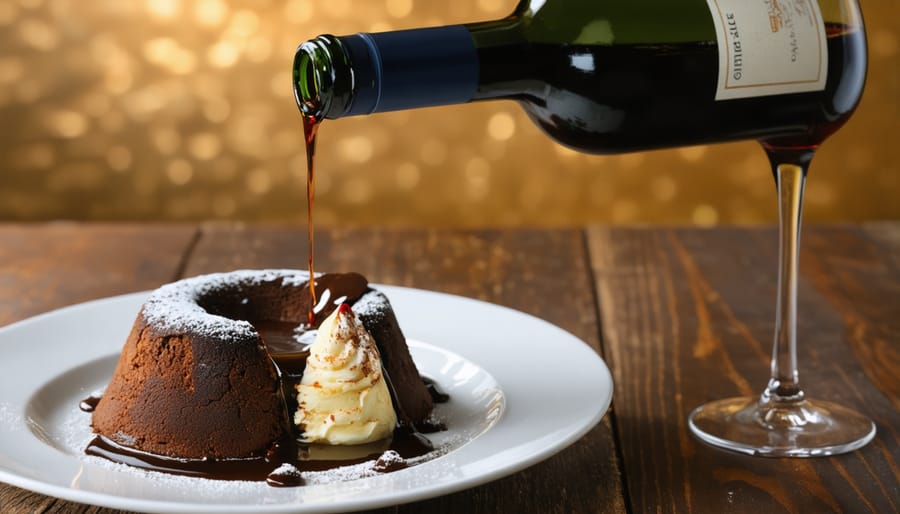
Matching Sweetness Levels
When it comes to dessert and wine pairings, the golden rule is simple: your wine should be at least as sweet as your dessert. I learned this the hard way when I once paired a dry red wine with chocolate cake – trust me, it wasn’t the dreamy combination I’d hoped for!
For fruit-based desserts like apple tart or poached pears, opt for wines with similar fruit notes. A late-harvest Riesling or Moscato d’Asti works beautifully here. If you’re serving chocolate desserts, reach for a Port or sweet red wine like Banyuls – their richness complements the cocoa perfectly.
For creamy desserts like crème brûlée or cheesecake, try a Sauternes or sweet Vouvray. Their honey-like sweetness and balanced acidity cut through the richness while matching the dessert’s sweetness level.
Remember, lighter desserts generally pair well with lighter wines, while richer desserts call for more full-bodied sweet wines. And here’s my favorite tip: when in doubt, a good quality Prosecco pairs surprisingly well with most desserts, making it your perfect backup plan!
Creating a memorable 5-course meal with perfectly paired wines is truly an art form, but one that’s absolutely within your reach. Remember, the key to success lies in the harmony between your dishes and wine selections, creating a journey that delights all the senses. Trust your instincts and don’t be afraid to experiment – some of the most delightful pairings come from thinking outside the box!
Consider keeping a small notebook handy during your dinner party to jot down which combinations your guests particularly enjoyed. This personal touch will help you refine your pairing skills for future gatherings. I’ve found that my most successful dinner parties weren’t just about the food and wine, but about creating an atmosphere where everyone feels relaxed and welcome.
For your first attempt at a formal wine pairing dinner, start with familiar flavors and classic combinations. As your confidence grows, you can venture into more adventurous territory. Remember to pace both the food portions and wine pours – moderation ensures your guests can fully appreciate each course and its accompanying wine.
Most importantly, don’t let the rules overwhelm you. While there are traditional guidelines for wine pairing, the ultimate goal is to create an enjoyable experience for you and your guests. Set a beautiful table, dim the lights, play soft background music, and let the evening unfold naturally. After all, great food, wonderful wine, and good company are the perfect ingredients for an unforgettable dining experience.



